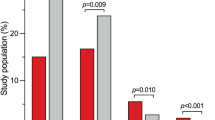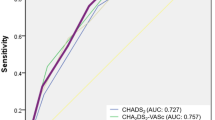Abstract
The Multicenter Automatic Defibrillator Implantation Trial II (MADIT II) and the Sudden Cardiac Death in Heart Failure Trial (SCD-HeFT) have established that patients with a reduced ejection fraction gain an overall mortality benefit from prophylactic implantable cardioverter-defibrillator therapy. Only a small proportion of the patients in these studies, however, have received life-saving therapy from the defibrillator. Because defibrillator therapy is invasive and expensive, patients with a low ejection fraction would benefit from effective risk stratification so that defibrillator therapy was used only in those at significant risk. In this review, we analyze prospective clinical trials that have evaluated microvolt T-wave alternans (MTWA) testing as a predictor of ventricular tachyarrhythmic events in populations of patients similar to those studied in MADIT II or SCD-HeFT; that is, patients with a reduced ejection fraction who were not selected on the basis of a history of ventricular tachyarrhythmias. In these studies, the average annual rate of fatal and nonfatal ventricular tachyarrhythmic events among the patients who tested negative for MTWA was around 1%. This rate is so low that it is unlikely that such patients would benefit from implantable cardioverter-defibrillator therapy. The mortality, moreover, was lower among MTWA-negative patients who did not receive implantable defibrillators than that observed in the MADIT II and SCD-HeFT patients who received implantable cardioverter-defibrillators. In response, patients with a low ejection fraction who are being considered for implantable cardioverter-defibrillator therapy should undergo MTWA testing as part of their evaluation.
This is a preview of subscription content, access via your institution
Access options
Subscribe to this journal
Receive 12 print issues and online access
$209.00 per year
only $17.42 per issue
Buy this article
- Purchase on Springer Link
- Instant access to full article PDF
Prices may be subject to local taxes which are calculated during checkout



Similar content being viewed by others
References
Moss AJ et al. (2002) Prophylactic implantation of a defibrillator in patients with myocardial infarction and reduced ejection fraction. N Engl J Med 346: 877–883
Buxton AE et al. (2000) Electrophysiologic testing to identify patients with coronary artery disease who are at risk for sudden death. Multicenter Unsustained Tachycardia Trial Investigators. N Engl J Med 342: 1937–1945
Bardy GH et al. (2005) Amiodarone or an implantable cardioverter-defibrillator for congestive heart failure. N Engl J Med 352: 225–237
AHA American Heart Association: Heart Disease and Stroke Statistics—2005 Update [http://www.americanheart.org/downloadable/heart/ 1105390918119HDSStats2005Update.pdf](accessed 17 August 2005)
Redfield MM et al. (2003) Burden of systolic and diastolic ventricular dysfunction in the community: appreciating the scope of the heart failure epidemic. JAMA 289: 194–202
Kadish A (2005) Prophylactic defibrillator implantation—toward an evidence-based approach. N Engl J Med 352: 285–287
Pavia S and Wilkoff B (2001) The management of surgical complications of pacemaker and implantable cardioverter-defibrillators. Curr Opin Cardiol 16: 66–71
Bigger JT (2002) Expanding indications for implantable cardiac defibrillators. N Engl J Med 346: 931–933
Hohnloser SH et al. (2004) Prophylactic use of an implantable cardioverter-defibrillator after acute myocardial infarction. N Engl J Med 351: 2481–2488
Lewis T (1910) Notes upon alternation of the heart. Q J Med 4: 141–144
Smith JM and Cohen RJ (1984) Simple finite-element model accounts for wide range of cardiac dysrhythmias. Proc Natl Acad Sci USA 81: 33–37
Smith JM et al. (1988) Electrical alternans and cardiac electrical instability. Circulation 77: 110–121
Nearing BD et al. (1991) Dynamic tracking of cardiac vulnerability by complex demodulation of the T wave. Science 252: 437–440
Gold MR et al. (2000) A comparison of T-wave alternans, signal averaged electrocardiography and programmed ventricular stimulation for arrhythmia risk stratification. J Am Coll Cardiol 36: 2247–2253
Rosenbaum DS et al. (1994) Electrical alternans and vulnerability to ventricular arrhythmias. N Engl J Med 330: 235–241
Restivo M et al. (2004) Spatial dispersion of repolarization is a key factor in the arrhythmogenicity of long QT syndrome. J Cardiovasc Electrophysiol 15: 323–331
Bloomfield DM et al. (2002) Interpretation and classification of microvolt T-wave alternans tests. J Cardiovasc Electrophysiol 13: 502–512
Bloomfield DM et al. (2004) Microvolt T-wave alternans distinguishes between patients likely and patients not likely to benefit from implanted cardiac defibrillator therapy. A solution to the Multicenter Automatic Defibrillator Implantation Trial (MADIT) II conundrum. Circulation 110: 1885–1889
Armoundas AA et al. (1998) Prognostic significance of electrical alternans versus signal averaged electrocardiography in predicting the outcome of electrophysiological testing and arrhythmia-free survival. Heart 80: 251–256
Klingenheben T et al. (2000) Predictive value of T-wave alternans for arrhythmic events in patients with congestive heart failure. Lancet 356: 651–652
Hohnloser SH et al. (2003) Usefulness of microvolt T-wave alternans for prediction of ventricular tachyarrhythmic events in patients with dilated cardiomyopathy: results from a prospective observational study. J Am Coll Cardiol 41: 2220–2224
Kitamura H et al. (2002) Onset heart rate of microvolt-level T-wave alternans provides clinical and prognostic value in nonischemic dilated cardiomyopathy. J Am Coll Cardiol 39: 295–300
Adachi K et al. (2001) Risk stratification for sudden cardiac death in dilated cardiomyopathy using microvolt-level T-wave alternans. Jpn Circ J 65: 76–80
Grimm W et al. (2003) Noninvasive arrhythmia risk stratification in idiopathic dilated cardiomyopathy: results of the Marburg Cardiomyopathy Study. Circulation 108: 2883–2891
Ikeda T et al. (2000) Combined assessment of T-wave alternans and late potentials used to predict arrhythmic events after myocardial infarction. A prospective study. J Am Coll Cardiol 35: 722–730
Ikeda T et al. (2002) T-wave alternans as a predictor for sudden cardiac death after myocardial infarction. Am J Cardiol 89: 79–82
Hohnloser SH et al. (2003) T-wave alternans negative coronary patients with low ejection and benefit from defibrillator implantation. Lancet 362: 125–126
Chow T et al. (2003) Microvolt T-wave alternans identifies MADIT II type patients at low risk of ventricular tachyarrhythmic events. [abstract] Circulation IV: 323
Costantini O et al. (2004) Patients with a nonischemic cardiomyopathy and a negative T-wave alternans stress test are at a low risk of death. Circulation 110 (Suppl III): 667
Raeder EA et al. (1992) Alternating morphology of the QRST complex preceding sudden death. N Engl J Med 326: 271–272
Acknowledgements
This work was supported by the US National Aeronautics and Space Administration, through grants from the National Space Biomedical Research Institute, and by an America Heart Association Beginning Grant-in-Aid (#0365304U) to AAA.
Author information
Authors and Affiliations
Corresponding author
Ethics declarations
Competing interests
RJ Cohen is a consultant and board member for Cambridge Heart Inc., a manufacturer of equipment for the measurement of microvolt T-wave alternans, and has a financial interest in the company. He is also a consultant for Medtronic Inc., a manufacturer of implantable cardioverter-defibrillators.
Rights and permissions
About this article
Cite this article
Armoundas, A., Hohnloser, S., Ikeda, T. et al. Can microvolt T-wave alternans testing reduce unnecessary defibrillator implantation?. Nat Rev Cardiol 2, 522–528 (2005). https://doi.org/10.1038/ncpcardio0323
Received:
Accepted:
Issue Date:
DOI: https://doi.org/10.1038/ncpcardio0323
This article is cited by
-
T-Wave Alternans as an Arrhythmic Risk Stratifier: State of the Art
Current Cardiology Reports (2013)
-
Microvolt T-wave alternans as a predictor of mortality and severe arrhythmias in patients with left-ventricular dysfunction: a systematic review and meta-analysis
BMC Cardiovascular Disorders (2009)



